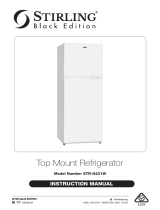
After Sales Support
(AU) 1300 886 649 (NZ) 0800 836 761 | info@tempo.org
5
Important Safety Instructions (Cont.)
Installation (see pages 7–8 for comprehensive installation instructions)
• Heavy: This appliance is heavy, take care when moving it. To avoid back or other injury,
consider a two person lift or mechanical aid when installing it. Failure to do so can
result in back or other injury. The appliance has two roll wheels underneath the back
corners for easy manoeuvrability.
• WARNING: Ventilation: To ensure proper ventilation, keep any ventilation openings,
in the appliance enclosure or in the built-in structure, clear of obstructions. Ensure
adequate air circulation around the appliance to prevent overheating.
• Level: Install the appliance level in order to ensure proper operation.
• Location: Choose a well ventilated indoor area that meets the following requirements:
—Ambient temperature: The ambient temperatures must correspond to the climate
class (T) indicated on the rating plate of the appliance: 18°C – 43°C.
—Floor surface: The floor must be sturdy, level and strong enough to support the
unit when it is fully loaded. We recommend you place a plastic mat underneath the
appliance if your floor covering is sensitive to moisture.
—Areas to avoid: Avoid areas where the appliance would be exposed to direct
sunlight, sources of heat (stove, heater, radiator, oven, etc.), extreme cold ambient
temperatures or excessive moisture and high humidity (such as outdoors or exposed
to wind, rain water spray or drips). Installing it in the coolest area of the room will
save energy consumption and running costs.
• WARNING! Electrical appliances: Do not place any appliances (e.g. microwave
ovens, rice cookers, voltage regulators etc.) on top of the chest freezer. Do not use any
electrical appliances (such as ice cream makers) inside refrigeration appliances, unless
they are approved for this purpose by the manufacturer.
• Personal safety: Take care when closing the appliance to avoid getting your fingers
caught in the small gaps between the storage cabinet and lid.
Cleaning and maintenance
• Disconnect: Unplug the appliance before cleaning or servicing. Failure to do so can
result in electric shock, injury or death.
• Flames: Do not let open flames or ignition sources enter the appliance.
• Flammable/explosive substances: Never clean this appliance with flammable fluids.
Do not store or use volatile, flammable or explosive substances such as aerosol cans
with a flammable propellant in or close to this or any other appliance. The fumes can
create a fire hazard or explosion.
• Solvents: Do not use solvent based cleaning agents or abrasives on the interior as
these may damage or discolour the surfaces of the appliances.
• WARNING! Do not use mechanical devices or other means to accelerate the defrosting
process, other than those recommended by the manufacturer. Never use a sharp or metal
instrument to remove frost or clean the appliance. Use a plastic scraper, if necessary.
• Service: Do not attempt to repair, modify or replace any part of the appliance unless
specifically recommended in this manual. Refer all other servicing to a qualified
technician, or contact our after sales support centre for advice.





















